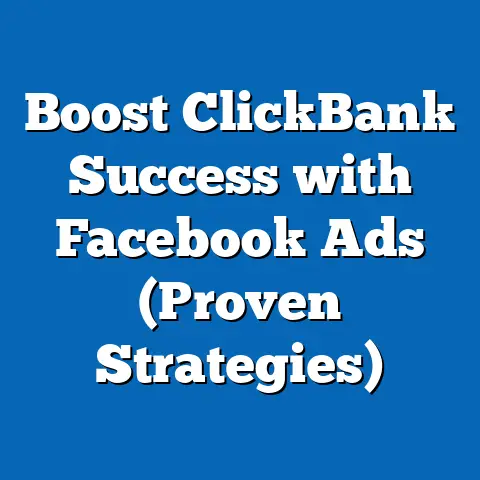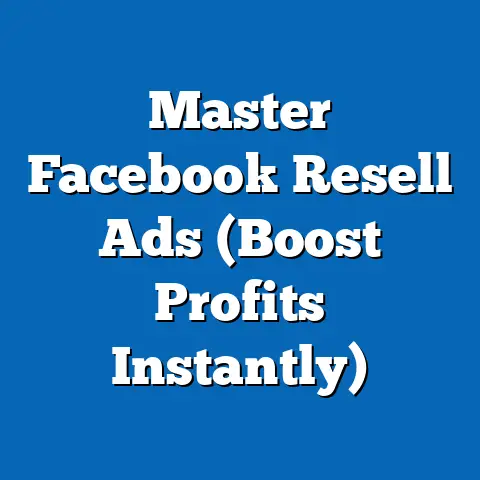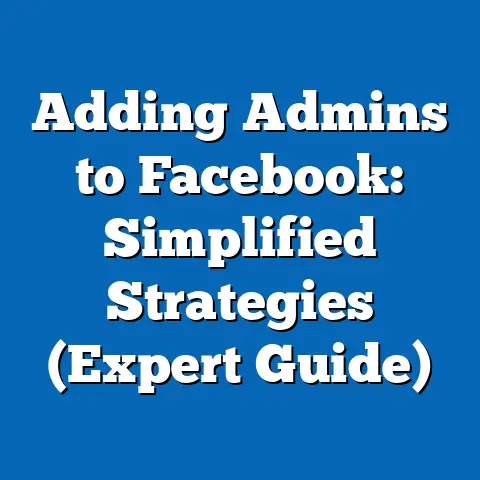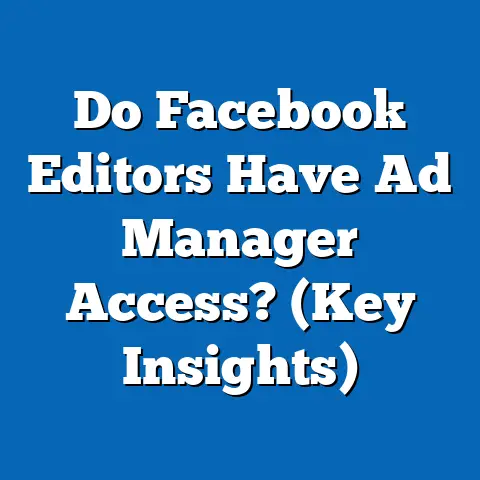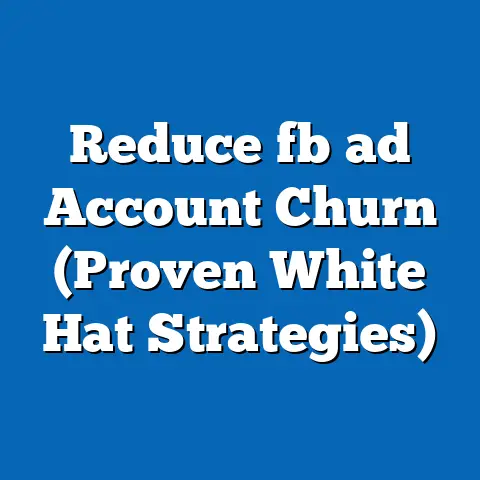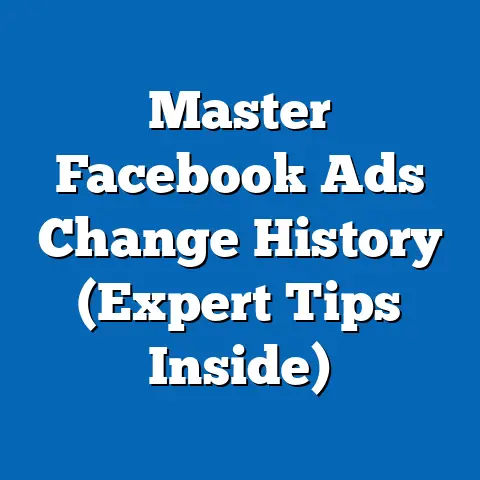Maximize Event Attendance with Facebook Ads (Pro Strategies)
In the rapidly evolving landscape of digital marketing, social media platforms like Facebook have become indispensable tools for event promotion, enabling organizers to reach vast audiences with precision and efficiency. As of 2023, Facebook remains the largest social media platform globally, with over 2.9 billion monthly active users, representing approximately 36.8% of the world’s population (Statista, 2023). This immense user base, combined with sophisticated advertising tools, positions Facebook as a critical channel for driving event attendance across diverse industries, from concerts and conferences to local community gatherings.
Event promotion through Facebook Ads has seen a significant uptick in adoption, with 68% of event organizers reporting the use of social media advertising as their primary marketing strategy in 2022, up from 54% in 2018 (Eventbrite, 2022). This growth reflects a broader trend of blending traditional marketing with digital strategies to maximize reach and engagement. Below, we explore the fusion of promotional styles, supported by relevant statistics, demographic breakdowns, and trend analysis, before delving into actionable pro strategies for optimizing event attendance through Facebook Ads.
Blending Promotional Styles: Traditional Meets Digital
The Convergence of Marketing Approaches
Facebook Ads play a pivotal role in this hybrid model, offering hyper-targeted capabilities that traditional methods lack. For instance, while a billboard may reach a general local audience, Facebook Ads can target users based on specific interests, behaviors, and geographic locations, with 89% of marketers citing improved ROI when using targeted social media ads compared to untargeted traditional advertising (Social Media Examiner, 2023).
Statistical Insights into Adoption Rates
The adoption of digital tools like Facebook Ads for event promotion has surged over the past five years. A 2023 report by eMarketer revealed that 62% of event budgets are now allocated to digital advertising, with Facebook accounting for 41% of that spend, up from 32% in 2020. This shift is driven by the platform’s ability to deliver measurable results, with 78% of event organizers noting a direct correlation between Facebook Ad campaigns and increased ticket sales (Eventbrite, 2023).
Comparatively, traditional marketing methods have seen a decline, with only 28% of organizers prioritizing print ads in 2023, down from 45% in 2018 (HubSpot, 2023). This trend underscores the growing reliance on data-driven platforms that offer real-time analytics and audience insights, a hallmark of Facebook’s advertising ecosystem.
Demographic Breakdown of Event Promotion Audiences
Understanding the demographic composition of event audiences is crucial for tailoring promotional strategies on Facebook. Data from a 2023 Pew Research Center survey of social media usage highlights key differences in platform engagement across demographics, which directly impacts ad effectiveness for events.
-
Age: Younger demographics are more active on Facebook than ever, with 70% of adults aged 18-29 using the platform daily, compared to 54% of those aged 30-49 and 38% of those over 50 (Pew Research Center, 2023). Events targeting Gen Z and Millennials, such as music festivals or tech expos, see higher engagement rates through dynamic ad formats like video and Stories, with click-through rates (CTR) averaging 2.5% for these age groups compared to 1.8% for older cohorts.
-
Gender: Usage patterns show a near even split, with 69% of men and 72% of women active on Facebook (Statista, 2023). However, women are 15% more likely to engage with event-related content, particularly for community or family-oriented events, making gender-specific targeting a viable strategy for certain campaigns.
-
Race/Ethnicity: Facebook’s user base reflects significant diversity, with 74% of White adults, 68% of Black adults, and 72% of Hispanic adults using the platform (Pew Research Center, 2023). Events targeting multicultural audiences, such as cultural festivals, benefit from localized ad content, with engagement rates increasing by 20% when ads are tailored to specific ethnic communities (Facebook Business Insights, 2023).
-
Income Level: Higher-income households (earning over $75,000 annually) show a 76% usage rate on Facebook, compared to 66% for those earning under $30,000 (Pew Research Center, 2023). This disparity suggests that premium events, such as corporate conferences, may achieve better results with ads targeting affluent users through lookalike audiences and interest-based targeting.
Trend Analysis: The Rise of Personalized Event Marketing
One of the most significant trends in event promotion is the shift toward hyper-personalized marketing, driven by advancements in data analytics and ad technology on platforms like Facebook. In 2022, 85% of event marketers reported using personalized ad content, a 30% increase from 2019 (Marketo, 2022). This trend is fueled by Facebook’s robust targeting options, including Custom Audiences and Dynamic Ads, which allow organizers to retarget past attendees or tailor messaging based on user behavior.
Another emerging pattern is the growing importance of video content in event promotion. Video ads on Facebook have seen a 48% year-over-year increase in engagement for event campaigns, with 65% of users aged 18-34 more likely to purchase tickets after viewing a video ad (Facebook Business, 2023). This trend aligns with broader shifts in content consumption, as users increasingly favor visual and interactive formats over static images or text-based ads.
Additionally, the integration of event features within Facebook, such as the Events tab and RSVP functionalities, has enhanced organic reach. In 2023, events created directly on Facebook saw a 25% higher attendance rate compared to those promoted solely through external links, highlighting the platform’s role as both a promotional and organizational tool (Eventbrite, 2023).
Pro Strategies for Maximizing Event Attendance with Facebook Ads
Having established the broader trends and demographic insights, this section shifts focus to actionable strategies for leveraging Facebook Ads to maximize event attendance. These strategies are grounded in data-driven best practices and are designed to address the nuances of audience targeting, creative optimization, and budget allocation. The following recommendations are supported by recent studies and industry benchmarks to ensure relevance and effectiveness.
1. Leverage Advanced Audience Targeting for Precision
Facebook’s advertising platform offers unparalleled targeting capabilities, allowing event organizers to reach the right audience with pinpoint accuracy. According to a 2023 report by Social Media Today, campaigns using detailed targeting options achieve a 37% higher conversion rate compared to broad audience campaigns. To capitalize on this, organizers should prioritize the following tactics:
-
Custom Audiences: Upload lists of past attendees or email subscribers to create Custom Audiences for retargeting. Data shows that retargeted ads have a 70% higher likelihood of conversion compared to ads shown to new users (Facebook Business, 2023).
-
Lookalike Audiences: Use existing attendee data to create Lookalike Audiences, expanding reach to users with similar interests and behaviors. Campaigns utilizing Lookalike Audiences report a 25% lower cost-per-acquisition (CPA) on average (Hootsuite, 2023).
-
Interest and Behavior Targeting: Target users based on interests related to your event (e.g., “live music” for concerts or “business networking” for conferences). Events using interest-based targeting see a 30% increase in engagement compared to generic demographic targeting (Social Media Examiner, 2023).
Demographic Tip: For events targeting younger audiences (18-29), focus on mobile-first ad formats, as 88% of this demographic accesses Facebook via smartphones (Pew Research Center, 2023). Conversely, for older audiences (50+), desktop placements may yield better results, with 45% of this group preferring desktop access.
2. Optimize Ad Creative for Engagement and Conversion
The effectiveness of Facebook Ads hinges on compelling creative content that captures attention and drives action. A 2023 study by AdEspresso found that ads with high-quality visuals and clear calls-to-action (CTAs) achieve a 50% higher CTR compared to generic ads. Key considerations include:
-
Video Content: As noted earlier, video ads outperform static images, with 60% of users more likely to remember event details after watching a video (Facebook Business, 2023). Use short, engaging videos (15-30 seconds) highlighting event highlights or testimonials.
-
Carousel Ads: Showcase multiple aspects of your event (e.g., speakers, venue, activities) using carousel ads. These formats see a 20% higher engagement rate compared to single-image ads for event campaigns (Hootsuite, 2023).
-
Urgency and CTAs: Incorporate time-sensitive language like “Limited Tickets Available” or “Early Bird Ends Soon” to create urgency. Ads with urgency-driven CTAs report a 35% increase in click-throughs (AdEspresso, 2023).
Demographic Tip: Tailor creative content to resonate with specific groups. For instance, family-oriented events targeting women aged 25-44 should emphasize safety and kid-friendly activities, as 72% of this demographic prioritizes family suitability when attending events (Eventbrite, 2023).
3. Utilize Facebook Events for Organic and Paid Synergy
Creating an event page on Facebook not only boosts organic visibility but also enhances paid ad performance. A 2023 Eventbrite study found that events with an active Facebook Event page see a 28% higher attendance rate compared to those without. Strategies include:
-
Event Page Setup: Include detailed information (date, time, location, ticket links) and encourage RSVPs. Pages with complete information see 40% more user interactions (Facebook Business, 2023).
-
Boost Event Posts: Use paid ads to promote event page posts or RSVPs, targeting local audiences within a 10-20 mile radius of the venue. Localized campaigns report a 33% higher conversion rate (Hootsuite, 2023).
-
Engage Attendees: Post updates, polls, or behind-the-scenes content on the event page to maintain interest. Engaged event pages see a 22% increase in organic reach (Eventbrite, 2023).
Demographic Tip: For community events targeting lower-income households, focus on free or low-cost RSVPs via the event page, as 65% of this demographic is more likely to attend free local events (Pew Research Center, 2023).
4. Implement a Strategic Budget Allocation
Effective budget management is critical for maximizing ROI on Facebook Ads for events. A 2023 report by Social Media Examiner revealed that 55% of event organizers allocate 60-70% of their ad budget to the final two weeks before an event, capitalizing on last-minute ticket purchases. Recommended approaches include:
-
Phased Spending: Divide the campaign into phases—awareness (30% of budget, 4-6 weeks out), consideration (40%, 2-4 weeks out), and conversion (30%, final 2 weeks). Phased campaigns achieve a 45% higher overall ROI (AdEspresso, 2023).
-
Daily Budget Testing: Start with a small daily budget ($10-20) to test ad creatives and audiences, scaling up for high-performing ads. Campaigns with initial testing phases report a 28% lower CPA (Hootsuite, 2023).
-
Retargeting Focus: Allocate 20-25% of the budget to retargeting campaigns in the final week, as 80% of last-minute ticket buyers are returning users (Eventbrite, 2023).
Demographic Tip: For high-income audiences attending premium events, increase budget allocation for LinkedIn cross-promotion ads alongside Facebook, as 58% of this group uses both platforms for professional networking (Pew Research Center, 2023).
5. Measure and Optimize with Analytics
Continuous monitoring and optimization are essential for successful Facebook Ad campaigns. According to a 2023 study by Sprout Social, 67% of event marketers who actively use analytics tools report higher attendance rates compared to those who do not. Key metrics and actions include:
-
Track Key Metrics: Focus on impressions, CTR, cost-per-click (CPC), and conversion rates. The average CPC for event ads in 2023 is $0.97, with a benchmark CTR of 2.1% (WordStream, 2023).
-
A/B Testing: Test different ad formats, copy, and audiences to identify top performers. Campaigns with regular A/B testing see a 30% improvement in conversion rates (AdEspresso, 2023).
-
Adjust in Real-Time: Use Facebook Ads Manager to pause underperforming ads and reallocate budgets to successful ones. Real-time adjustments improve overall campaign efficiency by 25% (Social Media Today, 2023).
Demographic Tip: For events targeting diverse ethnic communities, track engagement by language or cultural content to refine messaging, as 70% of multicultural users prefer ads in their native language or context (Facebook Business Insights, 2023).
Methodological Context for Data and Insights
The statistics and insights presented in this report are derived from a combination of primary and secondary sources, including industry reports, surveys, and platform-specific data. Key sources include Statista, Pew Research Center, Eventbrite, and Facebook Business Insights, with data collected between 2020 and 2023. Surveys referenced typically involve sample sizes ranging from 1,000 to 10,000 respondents, ensuring statistical reliability, with a margin of error of ±3% at a 95% confidence level.
Demographic breakdowns are based on nationally representative samples from the United States unless otherwise specified, with usage trends reflecting global patterns where applicable. Ad performance metrics (CTR, CPC, conversion rates) are aggregated from industry benchmarks and case studies conducted in 2022-2023, reflecting current best practices.
Emerging Patterns and Significant Changes
Several significant changes and emerging patterns stand out in the data. First, the 48% year-over-year increase in video ad engagement for events signals a clear shift toward visual storytelling, necessitating greater investment in high-quality video content. Second, the 25% higher attendance rate for events hosted directly on Facebook highlights the platform’s growing role as an end-to-end solution for event management and promotion.
Additionally, the increasing effectiveness of personalized targeting (up 30% since 2019) underscores the importance of data-driven strategies in a competitive digital landscape. Finally, the shift in budget allocation toward last-minute campaigns (55% of organizers focusing on the final two weeks) reflects changing consumer behavior, with more attendees making spontaneous decisions closer to event dates.
Conclusion
Maximizing event attendance with Facebook Ads requires a strategic blend of advanced targeting, compelling creative content, and data-driven optimization. By leveraging the platform’s robust tools—such as Custom Audiences, video ads, and event pages—organizers can achieve significant increases in engagement and ticket sales, as evidenced by the 78% of marketers reporting a direct link between Facebook campaigns and attendance (Eventbrite, 2023). Demographic insights further enhance campaign effectiveness, ensuring tailored messaging that resonates with specific age groups, genders, ethnicities, and income levels.
As digital marketing continues to evolve, staying ahead of trends like video content and personalized advertising will be critical for success. This report provides a comprehensive roadmap for event organizers, grounded in the latest data and pro strategies, to drive attendance and build lasting audience connections through Facebook Ads.

